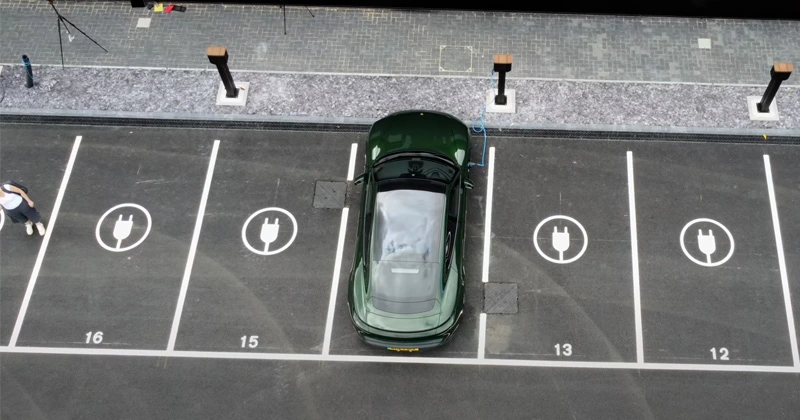Fleet electrification is becoming increasingly common as companies seek to reduce emissions and operating costs. Understanding what is fleet electrification is essential, as this trend is driven by technological advances, charging infrastructure availability, and financial incentives.
Fleet charging is an important aspect of fleet electrification planning. It can be a complex and time-consuming process, especially for companies with a large number of vehicles that need to be charged on a regular basis.
Top things to consider when electrifying your fleet:
Great British Bake Off Bookmakers: Betzella’s Guide to Unique Reality Show Bets
The Great British Bake Off has captivated audiences worldwide with its delightful blend of culinary artistry, friendly competition, and quintessential British charm. As the show’s popularity soars, a new phenomenon has emerged – the rise of bookmakers offering unique betting opportunities on the outcomes of this beloved reality series. Enter Betzella, a pioneering platform that has taken the Bake Off betting experience to new heights, catering to the insatiable appetite of fans seeking an extra layer of excitement.
In this comprehensive guide, we’ll delve into the world of Betzella’s Great British Bake Off betting markets, exploring the innovative and quirky wagers that have taken the online gambling scene by storm. From predicting the flavors of showstopper bakes to guessing the number of soggy bottoms, these unique bets add an extra dimension of engagement for viewers. But it’s not just about the thrill of the gamble; we’ll also examine the implications of this trend, the ethical considerations surrounding reality show betting, and the potential impact on the show’s integrity and viewership.
The Rise of Reality Show Betting: Exploring the Phenomenon
The Great British Bake Off has captivated audiences worldwide with its delightful blend of culinary artistry and heartwarming camaraderie. However, for those seeking an extra thrill, Betzella offers a unique opportunity to engage in reality show betting like never before. Their innovative platform allows you to wager on a variety of intriguing aspects of the beloved baking competition, adding an extra layer of excitement to your viewing experience.
One of Betzella’s most popular offerings is the “Star Baker Bet,” where you can predict which contestant will earn the coveted title in each episode. But that’s just the beginning. Betzella also allows you to bet on the type of baked goods that will be featured, the technical challenges the bakers will face, and even the quirky innuendos that have become a staple of the show’s humor. With a wide range of betting options, you can showcase your baking knowledge and intuition while potentially earning some sweet rewards.
Beyond the traditional bets, Betzella takes the experience to new heights with their “Baking Blunder Bets.” Here, you can wager on which contestant will suffer the most catastrophic baking mishap, from collapsed soufflés to burnt biscuits. It’s a lighthearted way to embrace the unpredictable nature of the competition while adding an extra layer of excitement to your viewing experience. So, whether you’re a seasoned bettor or simply looking for a fun way to engage with the show, Betzella’s Great British Bake Off betting options are sure to satisfy your cravings for both delicious treats and thrilling entertainment.
Unique Bet Types on Great British Bake Off
Bake Off bookmakers have taken the world by storm, offering unique betting opportunities on the beloved Great British Bake Off. Betzella, a leading online sportsbook, has emerged as a pioneer in this niche market, providing an array of exciting wagers for fans of the show. From predicting the winner to guessing the dreaded “soggy bottom” disasters, Betzella’s Bake Off bookmakers have something for everyone.
One of the most popular bets at Betzella is the “Star Baker” wager, where punters can place their money on who they think will be crowned the episode’s top performer. But that’s just the tip of the icing-covered iceberg. Betzella’s Bake Off bookmakers also offer odds on the type of baked goods featured each week, the likelihood of a contestant’s showstopper collapsing, and even the chances of a judge uttering a memorable catchphrase like “It’s a good bake!”
For those seeking a truly unique betting experience, Betzella’s Bake Off bookmakers have you covered. Prop bets abound, from wagering on the number of times a contestant will lick their spatula to guessing the color of the aprons worn by the judges. And for the true risk-takers, there are even bets on whether a contestant will shed a tear or suffer a baking-related injury.
- Predict the winner
- Guess the “soggy bottom” disasters
- Bet on the “Star Baker”
- Wager on the type of baked goods featured
- Bet on the likelihood of a showstopper collapsing
- Bet on memorable catchphrases
- Prop bets like licking spatulas and apron colors
- Bets on contestants shedding tears or suffering injuries
Strategies for Successful Bake Off Betting
Welcome to the world of “Great British Bake Off” betting, where the stakes are high, and the flavors are even higher! If you’re a fan of the beloved baking competition and looking to add an extra layer of excitement, Betzella has got you covered. Our unique reality show bets offer a thrilling experience that will have you on the edge of your seat, rooting for your favorite bakers while potentially raking in some sweet rewards.
Imagine the thrill of placing a wager on who will be crowned the next Star Baker or whose showstopper will crumble under the pressure. Will it be the seasoned pro with a flair for intricate decorations, or the dark horse who consistently delivers mouthwatering flavors? At Betzella, we offer a diverse range of betting options that cater to every taste. From predicting the technical challenge winner to guessing the dreaded “soggy bottom” victim, our innovative bets will keep you engaged from the first whisk to the final crumb.
- Star Baker Showdown: Bet on who will reign supreme as the episode’s Star Baker.
- Flavor Frenzy: Wager on the unique flavor combinations that bakers will incorporate into their creations.
- Showstopper Spectacular: Predict which baker will deliver the most awe-inspiring showstopper of the week.
- Soggy Bottom Blues: Guess which unfortunate soul will face the judges’ wrath for an undercooked masterpiece.
Analyzing Past Winners and Betting Trends
For fans of the beloved “Great British Bake Off” series, the excitement doesn’t stop at the tent’s entrance. Betzella, a pioneering online bookmaker, has taken the thrill to new heights by offering a unique range of betting options tailored specifically for this culinary extravaganza. From predicting the week’s Star Baker to guessing the dreaded soggy bottom victims, Betzella’s innovative platform allows enthusiasts to put their baking knowledge to the test and potentially reap sweet rewards.
Betzella’s offerings go beyond the conventional, delving into the intricate details that make “The Great British Bake Off” a beloved phenomenon. Bettors can wager on the flavor combinations that will grace the judges’ tables, the likelihood of a showstopper collapsing mid-presentation, or even the odds of a contestant shedding tears of joy or frustration. With an ever-evolving lineup of bets, Betzella keeps the excitement alive throughout the season, catering to both casual viewers and die-hard fans alike. So, whether you’re a seasoned baker or simply an appreciator of delectable treats, Betzella’s “Great British Bake Off” betting options promise an extra layer of anticipation and delight.
Responsible Gambling: Keeping it Fun and Safe
Welcome to the world of “Great British Bake Off” betting, where the stakes are high, and the rewards are deliciously sweet. At Betzella, we understand the thrill of putting your money on the line and the excitement of watching your favorite bakers battle it out in the iconic tent. That’s why we’ve crafted a unique range of betting opportunities that will have you on the edge of your seat, eagerly awaiting each episode’s outcome.
Imagine the rush of placing a wager on who will be crowned the “Star Baker” of the week or the heartbreak of watching your chosen contestant fall victim to a dreaded “soggy bottom.” With Betzella’s diverse betting options, you can revel in the drama and suspense that unfold with every challenge. From predicting the technical challenge’s outcome to guessing which baker will succumb to the pressure and crumble, our offerings cater to every level of “Great British Bake Off” enthusiasm.
- Will the showstopper live up to its name, or will it be a disappointing flop?
- Which baker will impress with their intricate decorating skills?
- Who will be the first to shed a tear over a failed bake?
At Betzella, we’ve taken the beloved “Great British Bake Off” experience to new heights, allowing you to immerse yourself in the action like never before. So, gather your fellow baking enthusiasts, place your bets, and let the delectable drama unfold. With our unique betting opportunities, every episode becomes a thrilling rollercoaster ride, where the only certainty is the delicious anticipation that awaits.
The Great British Bake Off has captured the hearts of millions with its delightful blend of baking prowess, friendly competition, and heartwarming camaraderie. As the show continues to captivate audiences worldwide, Betzella offers a unique opportunity for fans to immerse themselves even further in the excitement. From predicting the next Star Baker to guessing the technical challenge’s outcome, our diverse range of betting options adds an extra layer of thrill to this beloved reality show. So, whether you’re a seasoned bettor or simply a Bake Off enthusiast seeking a new way to engage with the series, Betzella invites you to join the fun and embrace the spirit of this quintessentially British phenomenon.
- Charging infrastructure: The first and most important consideration is the necessary charging infrastructure. This includes ensuring that you have enough chargers for your fleet and that they are placed in convenient locations that are easily accessible to your drivers.
- Charging speed: Another key factor to consider is the charging speed of the chargers you use. If your fleet needs to be charged quickly, you may want to invest in chargers with higher power outputs.
- Charging costs: While generally much lower than fuel, the cost of charging your fleet can add up quickly. It’s important to consider the costs associated with charging your vehicles. This includes the cost of electricity, as well as any fees associated with using public charging stations.
- Vehicle range: The range of your fleet vehicles is an important consideration for fleet charging. If your vehicles have a limited range, you must plan for more frequent charging.
- Charging schedules: To ensure that your fleet is charged and ready to go when needed, you’ll need to develop a charging schedule that works for your business. This may involve scheduling charging times around the clock or only charging during certain times of the day.
Deciding where drivers charge
There are several scenarios for fleet charging, including charging at the workplace, employee homes, and public chargers.
- Workplace: One fleet charging option is installing chargers at the workplace. This can be convenient for employees who drive electric or hybrid vehicles as part of their job, as they can charge their vehicles while they are at work.
- Employee homes: Another option is to encourage employees to charge their vehicles at home. Employees can charge their vehicles overnight and have a full battery when they come to work in the morning.
- Public chargers: In addition to charging at the workplace or at home, fleet vehicles can also be charged at public charging stations. These stations are typically located in convenient locations such as shopping centers, parking garages, and along highways. Many public charging stations offer fast charging options, which can be useful for fleet drivers who need to charge their vehicles quickly.
Reimbursing for home charging
If your company allows employees to charge their vehicles at home, there are several options for reimbursing this expense:
- Miles reimbursement – One option is to offer an amount based on the number of miles driven in a given period. This option is relatively simple to implement, as it does not require tracking individual charging expenses.
- Actual cost – Another option is to reimburse employees for their actual charging expenses. To do this, employees must use smart chargers that connect to a management system that keeps track of their energy use. This system is also aware of the home electricity tariff. At the end of the month, the system calculates the actual cost incurred by the driver and integrates into the payroll system for reimbursement.
Charging on-the-go
Public charging and EV roaming are important tools for charging on the go:
Public charging stations are typically located in convenient locations such as parking garages, shopping centers, and along highways. Many public charging stations offer fast charging options. This is useful for drivers who need to charge their vehicles quickly. The fleet manager must reach a commercial agreement with a charge point operator (CPO). It would then provide drivers with that operator’s RFID or an App to use with the chargers.
Using EV roaming, fleet drivers can use charging stations by multiple charge point operators. In that case, the fleet manager reaches a commercial roaming agreement with multiple providers. The fleet manager then uses the fleet’s RFID or App to roam to those other networks. Behind the scenes, the OCPI protocol is used. Roaming can be useful for fleets that operate in multiple locations, as it allows them to access charging stations wherever they go.
Choosing the right EV fleet management platform
When choosing an EV fleet management platform, there are several factors to consider:
- Compatibility: The platform should be compatible with the vehicles in your fleet and any charging infrastructure you already have in place.
- Features: Look for a platform that offers the needed features, such as employee home charging reimbursement, workplace charger support and roaming to public networks.
- Scalability: Choose a platform that can grow with your fleet, whether you are a small company with a few vehicles or a large fleet with many vehicles.
- Integration: Consider whether the platform integrates with other systems that you use, such as billing and invoicing software or payroll systems.
- Customer support: Look for a platform with responsive customer support, as you may need help with setup or troubleshooting.
- Interoperability and security: The Open Charge Point Protocol (OCPP) is a communications protocol that enables interoperability between charging stations and central systems. Make sure that the platform you choose is OCPP certified. This will ensure interoperability and security and prevent vendor lockdown.
- Public network agnostic: The Open Charging Interface Protocol (OCPI) allows fleet operators to access and use charging stations from different networks, providing greater flexibility and range for their electric or hybrid vehicles. If you plan to use public charging, ensure the platform is compatible with this protocol.
Considering these factors, you can choose an EV fleet management platform that helps you manage your fleet efficiently.
Wevo Energy is a leading provider of software solutions for EV Fleets. We provide a software platform that supports every scenario: apartment complexes, workplaces, fleets, destinations, and public charging.


